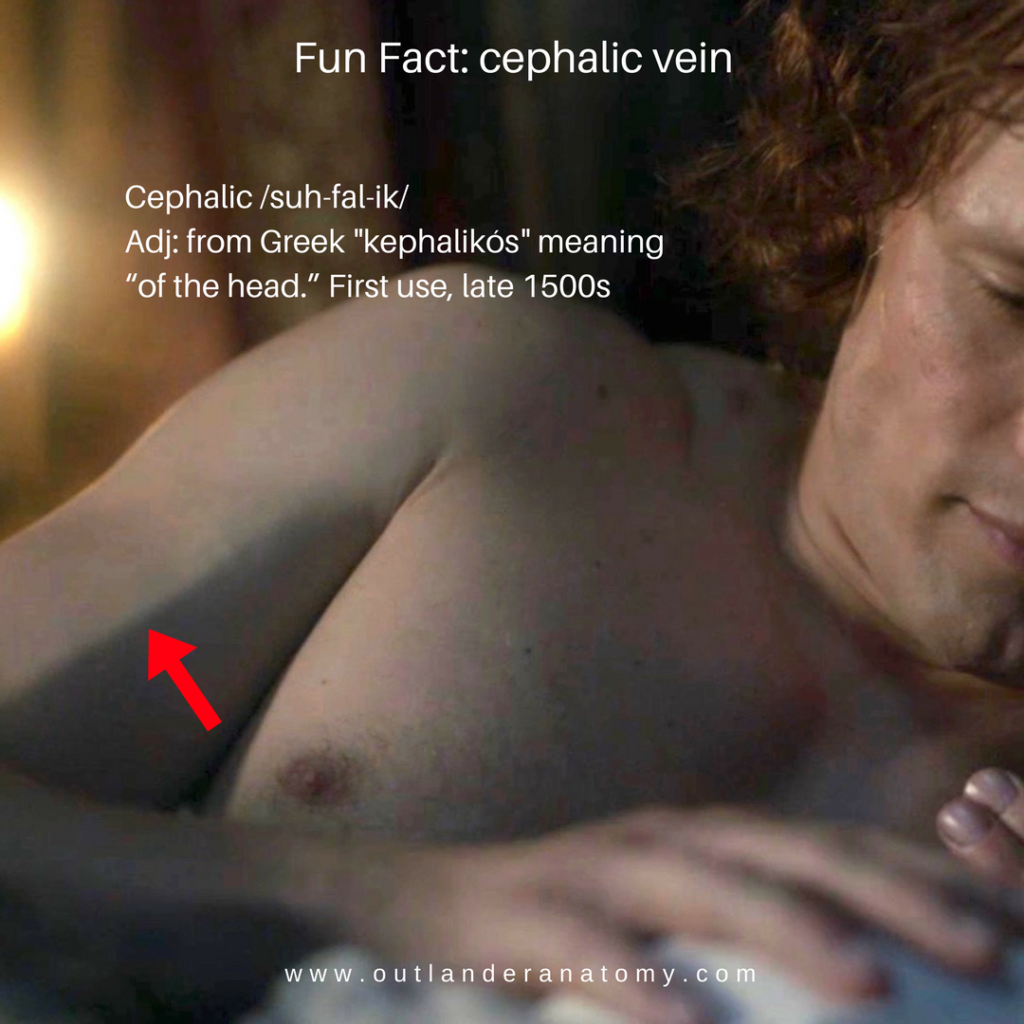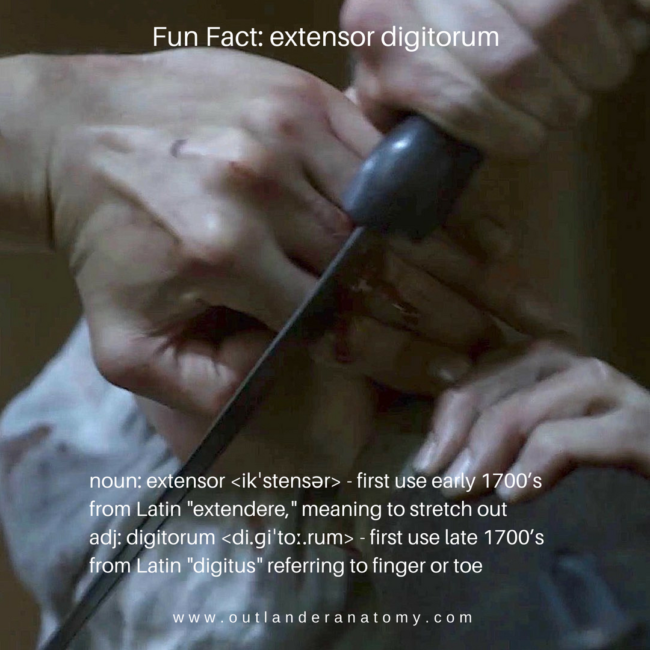Tommy Lee Jones, starring as Hawk Hawkins in Space cowboys (2000), said it best (Image A):
Where the hell is the pancreas, anyway? I don’t even know what the damn thing does beside give you cancer!
Terrific question, Hawk! Welcome anatomy students to Lesson #50, the pancreas. Our goal today is to answer Hawk’s question and more: what is the pancreas, what does it look like, where is it located, what does it do, and what diseases plague it?
This is the 7th and final lesson of the immense gastrointestinal tract and associated organs! Turns out, pancreas is one of these “Klingon” organs.
Although Diana hasn’t written a great deal nor has Starz episodes showed much about the pancreas, there are bits and pieces here and there. As always, these are scattered throughout the lesson. I hope you find the pancreas as compelling as your body does. Off we go!

Image A
History: Herophilus (335-280 BCE), Greek anatomist and surgeon (Image B), helped found the ancient school of Medicine in Alexandria, Egypt. He also championed human dissection and was the first to describe the pancreas. Students may recognize Herophilus because he also featured in Anatomy Lesson #34, The Amazing Saga of Human Anatomy.
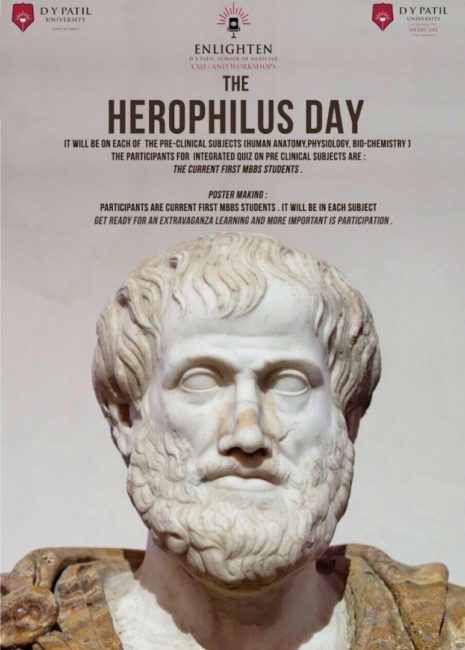
Image B Herophilus
Gross Anatomy: The word, pancreas, comes from the Greek pan, meaning “all,” plus the Greek kreas, meaning “flesh;” so, “all flesh.” A seemingly odd term until one views the pancreas and then, it seems sensible as it appears markedly fleshy, soft, and squishy (Image C).
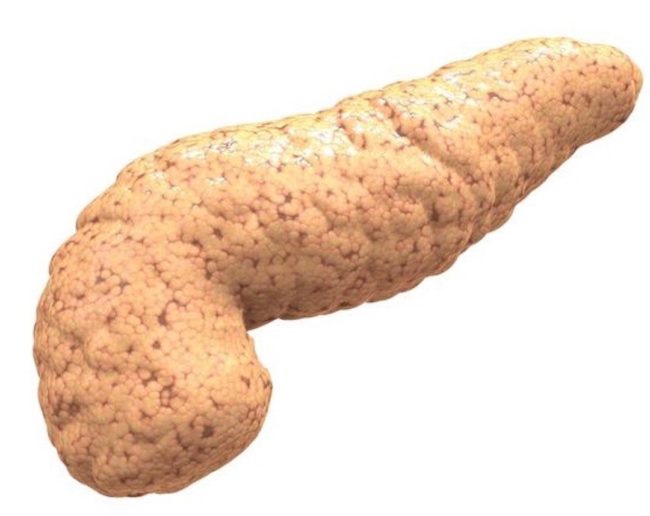
Image C pancreas
Outlander Fix #1: Answering Hawk’s first question, “Where the hell is the pancreas, anyway?”, Mary-Mary-Quite-Contrary knows (Starz episode 211, Vengeance is Mine). Or, rather, Mary’s Knife-Knows! Och, lass, that is Jamie’s dirk. Careful! Verra sharp!
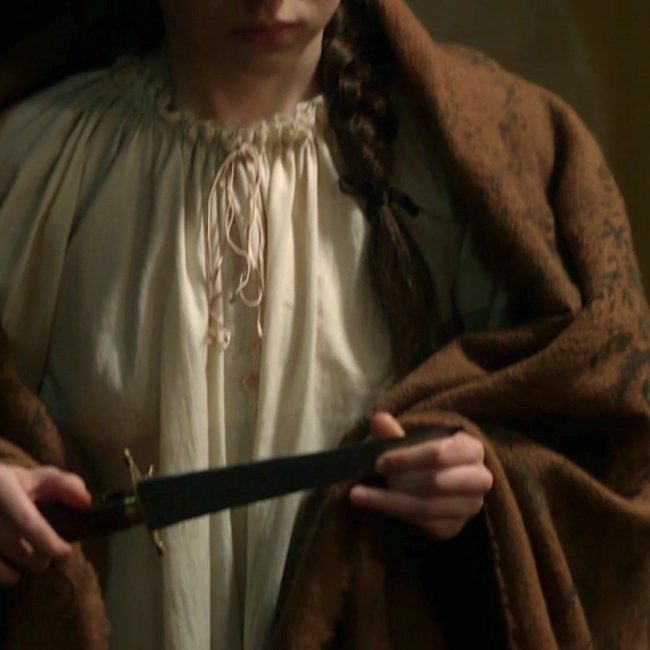
The dirk finds it’s mark, pretty much where the pancreas lives! A grim ending to a vicious valet. And he isn’t the only one taking a hit from a blade in this episode. Written by our own beloved Diana, this gratifying chapter brings some very bad players to their just desserts (Starz episode 211, Vengeance is Mine), although that mad bastard captain remains at large. Come on S.3!
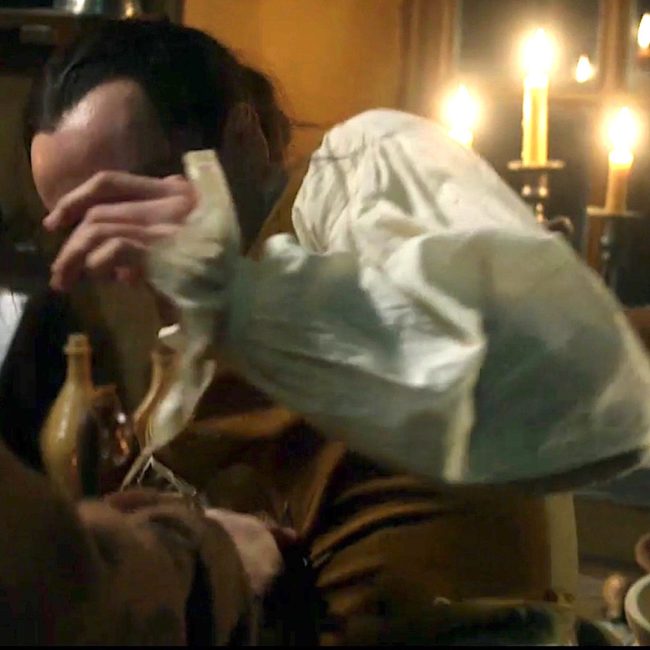
On to anatomy!
Pancreas Location: The pancreas (Image D) lies in the upper abdominal cavity behind the stomach (Anatomy Lesson #46: Splendid Stomach, Wobbly Wame). Oriented almost horizontally, it extends from the curve of duodenum to the spleen, a distance of some 6” (15 cm). In this position, it contacts stomach, spleen, duodenum, colon, jejunum, bile ducts, and major intestinal blood vessels. Pillowed among other soft abdominal organs, its location is pertinent, especially in pancreatic cancer as we shall shortly see. It lies between T12 and L2 vertebral levels.
Try this: Place thumb on the xiphoid process (tip of sternum – Anatomy Lesson #15: Crouching Grants – Hidden Dagger) and little finger of the ipsilateral (same) hand on your umbilicus. The xiphoid process is located at T9-T10 vertebral levels; the umbilicus at L3-L4. Now, place a finger of the contralateral (opposite) hand midway between xiphoid and umbilicus – this is the approximate vertebral level where your pancreas dwells. These new terms are thrown in to enlarge your anatomy vocab!
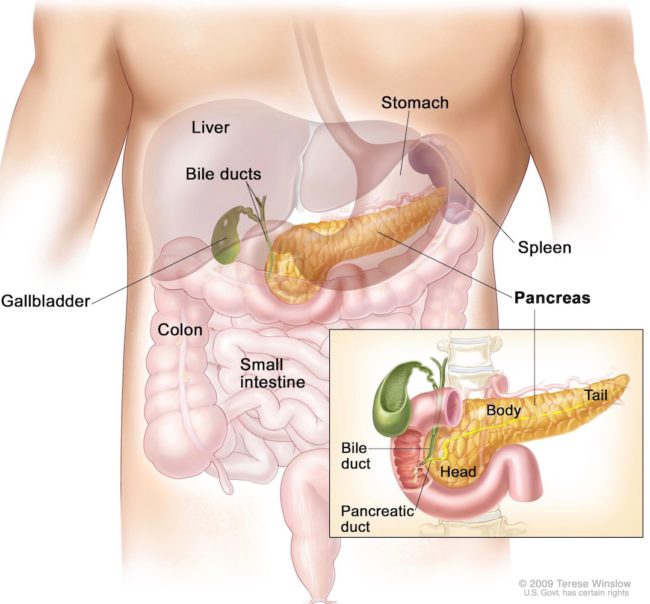
Image D
Divisions: Although many sources describe three divisions of the pancreas, it actually has five: head, neck, body, tail, and uncinate process (Image E). The head tucks into the C-shaped curve of duodenum. A short neck lies between head and body. The body supplies most of its 6” length. The tail tucks into the spleen (review Image D). The uncinate process (Latin meaning hook-shaped) is the smallish part that tucks in behind some large blood vessels of the gut.
You might consider these segments as rather arbitrary, but they are very useful in localizing disease entities, particularly pancreatic cancer.
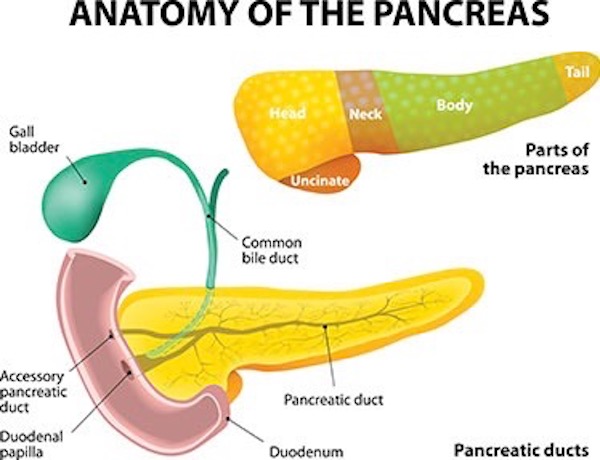
Image E
Gland: The pancreas is an organ but it is also a gland meaning it produces and releases secretions (products). It is also a mixed gland meaning it it is both exocrine and endocrine gland. Now, most glands are either exocrine or endocrine in type, but the pancreas is unusual because it is both.
Exocrine: Exocrine glands release products into ducts which carry the secretions to a destination. In this case, pancreatic exocrine secretions flow into the pancreatic duct (Image F) which joins the common bile duct (Anatomy Lesson #49, Our Liver – The Life Giver!) before entering the duodenum. Pancreatic exocrine secretions include an array of enzymes that digest various dietary substances, including:
- carbohydrates
- lipids (fats)
- proteins
- nucleic acids (DNA, RNA)
Finally, the duct system draining the pancreas produces bicarbonate to help neutralize acidic foodstuffs released by the stomach into the duodenum (Anatomy Lesson #46, Splendid Stomach, Wobbly Wame).
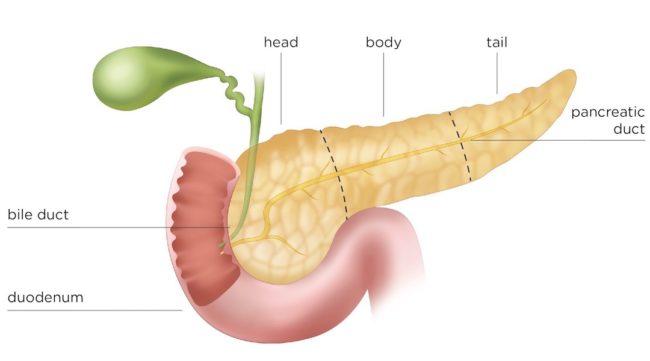
Image F
Endocrine: Endocrine gland secretions are picked up and distributed throughout the body by the blood stream – no ducts involved! And most of such secretions are classified as hormones or hormone-like substances. The pancreas produces its hormones via small spherical islands of cells formally known as pancreatic islets of Langerhans (brilliant German pathologist). About 3 million tiny islets (Image G – violet clusters) are scattered throughout the pancreas although more are concentrated in the tail region. Their combined mass is only about 2 grams (.0022 pounds). Yet, their effects in the body are profound!
These tiny clusters contain five different types of cells, producing the following compounds:
- glucagon (stimulates cells to release glucose – raises blood sugar levels)
- insulin (causes cells to absorb glucose – lowers blood sugar levels)
- somatostatin (regulates release of glucagon and insulin)
- pancreatic polypeptide (regulates intestinal function)
- ghrelin, the “hunger hormone” (regulates appetite – pancreas produces small amounts of this compound – stomach is major source)
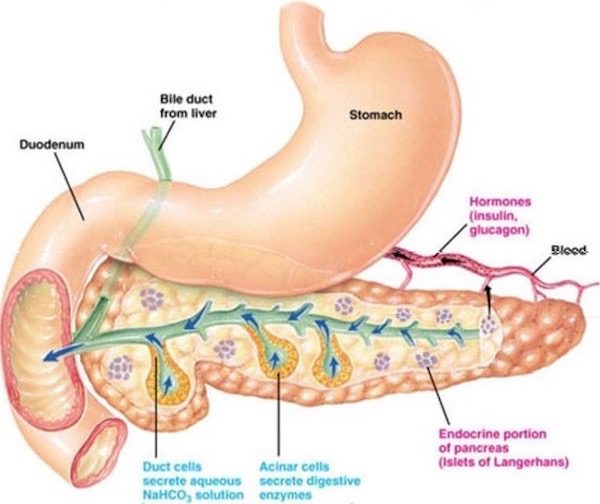
Image G
Outlander Fix #2: Yay! Claire fixes her mind on her pancreas in Dragonfly in Amber book. Yep, she does! (Psst…the image is from their Paris days – Starz episode 203, Useful Occupations and Deceptions – not from Lallybroch.) Not a perfect match with the quote, but Claire in bed is always good, especially if Jamie is nearby. Dinna ken how Claire’s mind fixes around her pancreas, but I do trust the lass! <g>
As I began to hover on the edge of sleep, my mind fixed somewhere around my pancreas, I could dimly hear the sounds of small Jamie pattering down the hall to his mother’s bedroom—roused from sleep by a full bladder, he seldom had the presence of mind to take the obvious step, and would frequently blunder down the stair from the nursery in search of assistance instead.
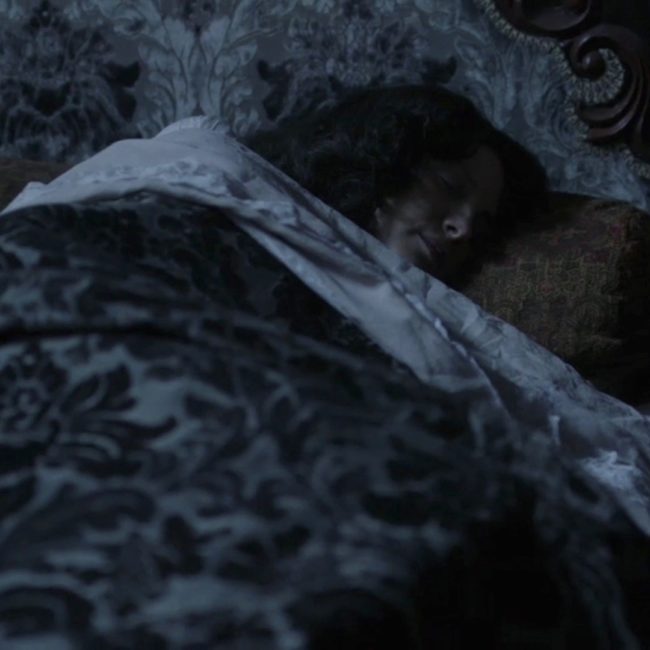
Buh-bye Claire – Thank you for the pancreas lesson!
Microscopy: Exocrine and endocrine pancreas are readily differentiated by microscopy. Bear with me, folks-without-training-in-microscopy, as I explain. Image H is a thin slice of pancreas stained with dyes (H&E). The red globs are pre-enzymes inside deep purple exocrine cells. After release as enzymes, they enter the pancreatic ducts and are transported to the duodenum. The pale violet blob in the center is a pancreatic islet of Langerhans. This blob contains tiny purple ovals, nuclei of the five different cell types mentioned above; collectively, these islets form the endocrine part of the pancreas. In 3-D, the pale blob is spherically- shaped.
This exercise is important to explain how anatomical pathologists diagnose disease. They learn to recognize normal pancreas (and all other organs) in the microscope. This enables them to determine if a tissue sample lies outside that expectation and, if it does, what disease does it best match. This ability is called pattern recognition. Got it? Grand!

Image H
Diseases: Like other organs, the pancreas has its own palate of diseases and many have devastating effects. There are three major players:
- Pancreatitis: means inflammation of the pancreas. Acute and chronic types. Most common cause is alcoholism. Its own enzymes start digesting pancreatic tissue – Painful!
- Diabetes mellitus: Types 1 and 2 interfere with sugar (glucose) uptake by body cells, although causes are different.
- Pancreatic cancer: one of the more infamous cancers, it has a very low survival rate – overall five year survival rate is only 7%.
Outlander Fix #3: Claire’s own words from Dragonfly in Amber book inform us of a L’Hôpital des Anges’ patient with sugar sickness (Type 1 diabetes). Starz episode 203, Useful Occupations and Deceptions, faithfully brings Diana’s lines to life!
I bent over a pallet at the edge of the floor. A very thin woman lay listlessly under a single blanket, her eyes drifting dully over us without interest.
It wasn’t the woman who had attracted my attention, so much as the oddly shaped glass vessel standing on the floor alongside her pallet. The vessel was brimming with a yellow fluid—urine, undoubtedly.
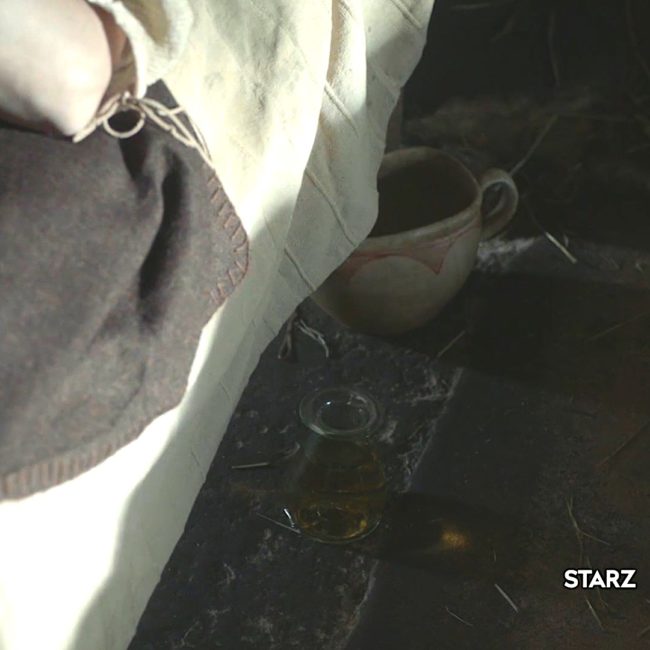
psssst: The oddly shaped glass vessel used in the episode is an Erlenmeyer flask. It wasn’t invented until 1861 <g>
I was mildly surprised; without chemical tests, or even litmus paper, what conceivable use could a urine sample be? Thinking over the various things one tested urine for, though, I had an idea. I picked up the vessel carefully, ignoring Sister Angelique’s exclamation of alarmed protest. I sniffed carefully.
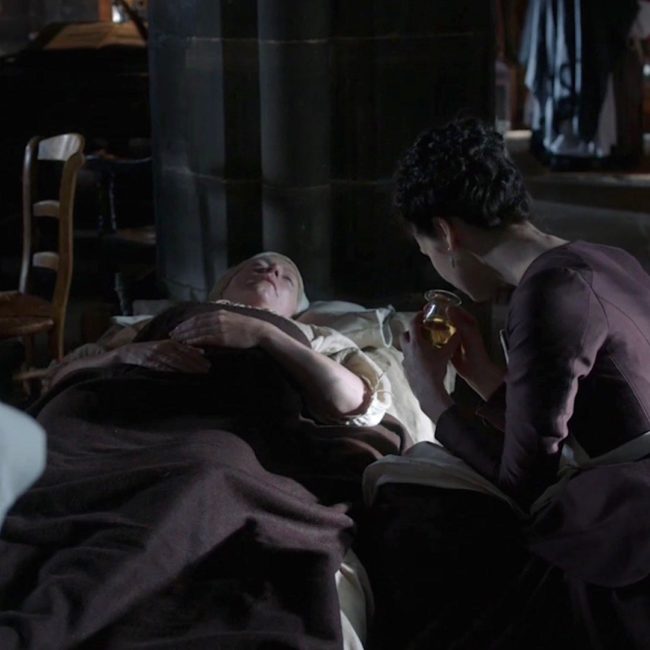
Sure enough; half-obscured by sour ammoniac fumes, the fluid smelled sickly sweet—rather like soured honey. I hesitated, but there was only one way to make sure. With a moue of distaste, I gingerly dipped the tip of one finger into the liquid and touched it delicately to my tongue.
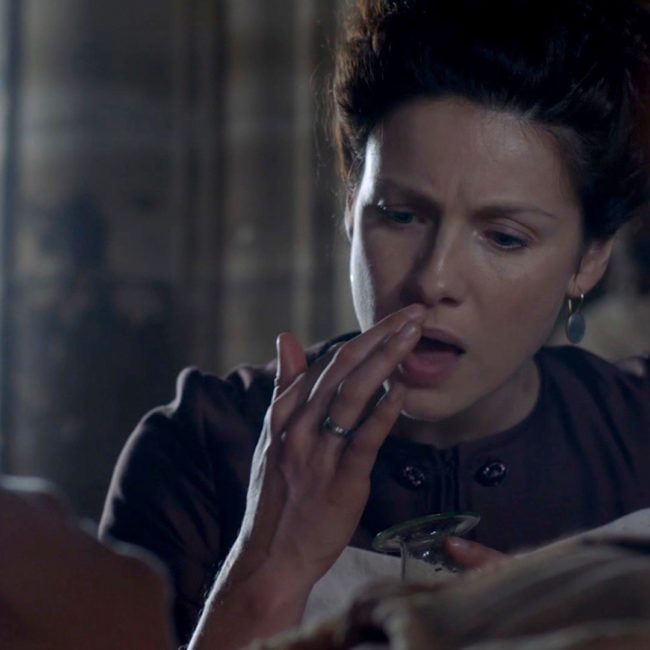
…Sister Angelique was watching with sudden interest. … “Are you thirsty, Madame?” I asked the patient. I knew the answer before she spoke, seeing the empty carafe near her head. “Always, Madame,” she replied. “And always hungry, as well. Yet no flesh gathers on my bones, no matter how much I eat.” She raised a stick-thin arm, displaying a bony wrist, then let it fall as though the effort had exhausted her.
I patted the skinny hand gently, and murmured something in farewell, my exhilaration at having made a correct diagnosis substantially quenched by the knowledge that there was no possible cure for diabetes mellitus in this day; the woman before me was doomed.
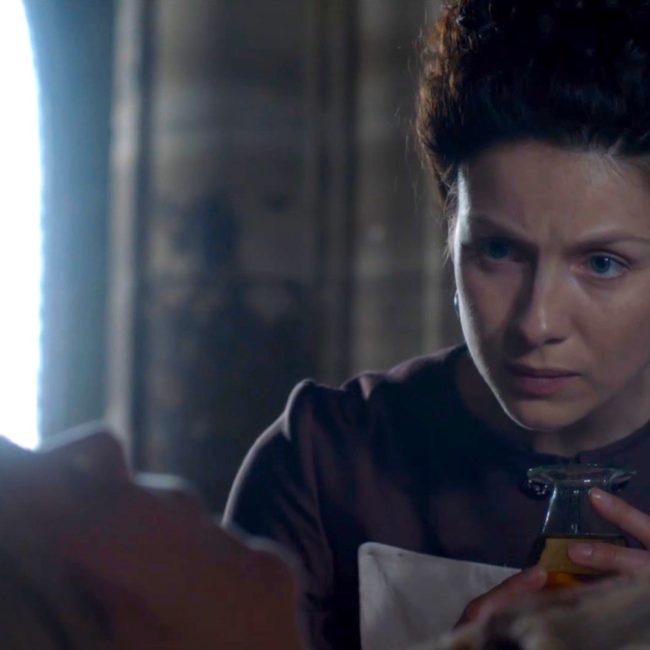
In subdued spirits, I rose…“Could you tell from what she suffers, Madame?” the nun asked curiously (Mother Hildegarde in the Starz episode). “Only from the urine?” “Not only from that,” I answered. “But yes, I know. She has—” Drat. What would they have called it now? “She has … um, sugar sickness. She gets no nourishment from the food she eats, and has a tremendous thirst. Consequently, she produces large quantities of urine.” … “And can you tell whether she will recover, Madame?” “No, she won’t,” I said bluntly. “She’s far gone already; she may not last out the month.”
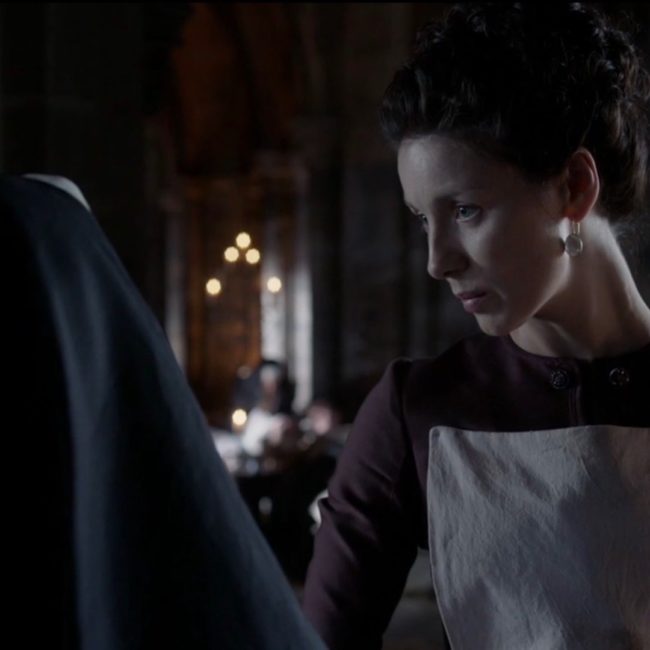
Is Jamie please with Claire tasting urine and treating scrofula? Noooo….he doesn’t want his pregnant wife messing with piss and pus! Och!

History of Diabetes Mellitus: Diabetes was described three millennia before Claire sampled her patient’s urine. About 1500 BCE, Sushruta, the Indian physician, wrote the first description of diabetes mellitus, noting that ants and flies were attracted to the urine of people with a mysterious disease causing intense thirst, enormous urine output, and wasting away of the body.
In 250 BCE, Apollonius of Memphis (Egypt), coined the term diabetes meaning “I pass through.” Later, mellitus, Latin for “honey-sweet,” was added to emphasize the sugar content of the urine and to distinguish diabetes mellitus from diabetes insipidus, a disorder of the pituitary gland also characterized by intense thirst and high production of urine.
Finally, the Greek physician, Aretaeus (Image I) wrote this description in the second century AD:
“Diabetes is … not very frequent … being a melting down of the flesh and limbs into urine … for the patients never stop making water, but the flow is incessant, as if from the opening of aqueducts. It consists in the flesh and bones running together into the urine … the illness develops very slowly. The nature of the disease is chronic, and it takes a long period to form; but the patient does not live long once the disease is fully established; for the melting is rapid, the death speedy. Moreover life is disgusting and painful; thirst, unquenchable … and one cannot stop them either from drinking or making water”.

Image I
Simple Physiology: Our bodies contain millions of cells. These cells use glucose to make energy for our daily activities: heartbeat, muscle contraction, fighting redcoats. Snort! How do cells get glucose? When you eat or drink, food is broken down inside the gut into simple proteins, lipid components, and sugars, mostly glucose. Glucose enters the bloodstream and circulates. Although circulating glucose contacts body cells, they cannot absorb it on their own.
So, circulating glucose stimulates pancreatic (beta) islet cells to release insulin into the blood stream. Insulin circulates with the glucose and acts as a key to permit body cells to absorb glucose. No matter how much glucose circulates in the bloodstream, insulin is required for it to enter the cells: no insulin – no glucose uptake! The following brief You Tube cartoon illustrates the process very well.
http://youtu.be/OYH1deu7-4E
Oh, and just so you ken, insulin produces 9 effects in the body. Glucose uptake is only one of these.
I like this cute T, but it is slightly misleading. The pancreas doesn’t really ask for sugar. Rather, pancreatic cells check blood glucose levels and as those levels rise, it releases insulin to induce body cells take in sugar. If glucose blood levels fall below normal, then the pancreas releases glucagon which mobilizes stored glucose for released into the blood stream. A very clever check and balance system.
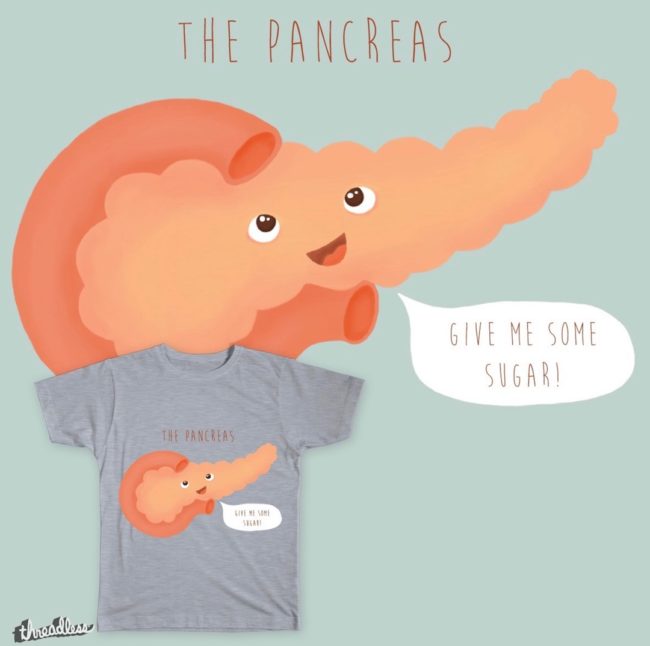
Image J shirt
Type 1 (I) Diabetes Mellitus (DM): Simply put, Type 1 DM is a chronic condition wherein the pancreas produces little or no insulin so glucose cannot enter cells. Instead, glucose stays in the bloodstream, spilling into the urine, and pulling water with it; hence, the continuous thirst and high urine production (polyuria). Even today, there is no cure for Type 1 DM but it can be managed, usually with daily doses of insulin.
The exact cause of Type 1 DM remains unknown despite decades of intense research. In many, the body’s own immune system mistakenly destroys insulin-producing (beta) cells of the pancreatic islets. Both genetics and viral infections appear to play important roles in the development of diabetes.
Type 2 (II) DM: Type 2 DM occurs when the pancreas doesn’t produce enough insulin or cells are unable to recognize the insulin and use it properly, a state known as insulin resistance. Insulin resistance is the most common cause of Type 2 DM. Here, genetics and lifestyle are important risk factors. According to the US CDC, obesity and lack of physical activity are responsible for 95% of Type 2 DM in the US!
Pancreas Transplant: Yes, these surgeries are done. A pancreas transplant is a surgical procedure to place a healthy pancreas from a deceased donor into a person whose pancreas no longer functions properly (Image K). Most transplants are done to treat Type 1 DM, and, occasionally for Type 2. Although a transplant offers a potential cure for DM, it is generally reserved for folks with serious diabetes complications because the side effects of a pancreatic transplant are significant.
The donor pancreas plus the segment of duodenum that receives the pancreatic duct are transplanted into the cecum of the large intestine (Anatomy Lesson #48, The Big Guy!). So, the recipient then has a pelvic pancreas. Such surgeries must be disclosed to new health care professionals so they are aware of unexpected changes in typical anatomy.
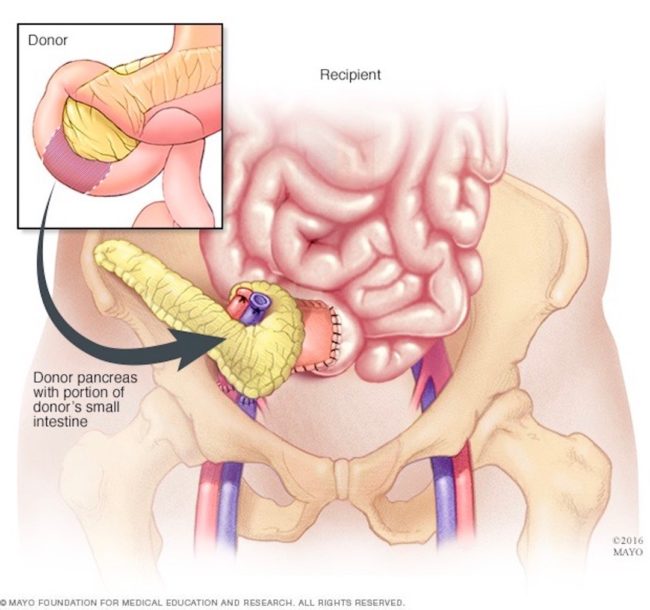
Image K
Pancreatic Cancer: Many of us have lost a family member, friend, or acquaintance to pancreatic cancer. This type of cancer is often detected late, spreads rapidly, and has a poor prognosis. Why? Unfortunately, early stages of this cancer are mostly asymptomatic. Later stages are associated with symptoms, but these can be non-specific, such as lack of appetite and weight loss. So, the cancer may be advanced before detected.
Pancreatic cancer is staged 0-IV depending on its spread (Image L). Early in this lesson, we learned that the pancreas is in contact with duodenum, jejunum, colon, spleen, stomach, bile ducts, and blood vessels, providing many opportunities for metastases. Also, these surrounding organs are soft, so a spreading cancer has considerable space to grow before creating an organ stramash.
As you might assume, the prognosis is better for those whose pancreatic cancer is diagnosed at an early stage. The median survival rate after diagnosis and medical treatment is still abysmal: only 6 to 12 months. Let us be grateful it isn’t one of the three most common cancers.
True story: one of my neighbors was diagnosed with pancreatic cancer in the 1960’s. She survived a Whipple procedure, a.k.a., pancreaticoduodenectomy, which is why it is called a Whipple! This horrific surgery removes head of pancreas, duodenum, gallbladder, part of common bile duct, and part of stomach. She was a lucky lady who raised three sons and survived into her 80’s!
A possible piece of good news: New Scientist magazine (15 April 2017) reports that, by chance, a drug used to treat strokes has been found to significantly prolong the lives of mice with pancreatic cancer. Turns out, pancreatic cancers are protected by a capsule of connective tissue that acts like a coat of armor. Australian researchers found the stroke drug, fasudil, weakens the capsule, making it easier for chemotherapeutic agents to reach the tumor. Drug trials in humans are planned. Fingers crossed!
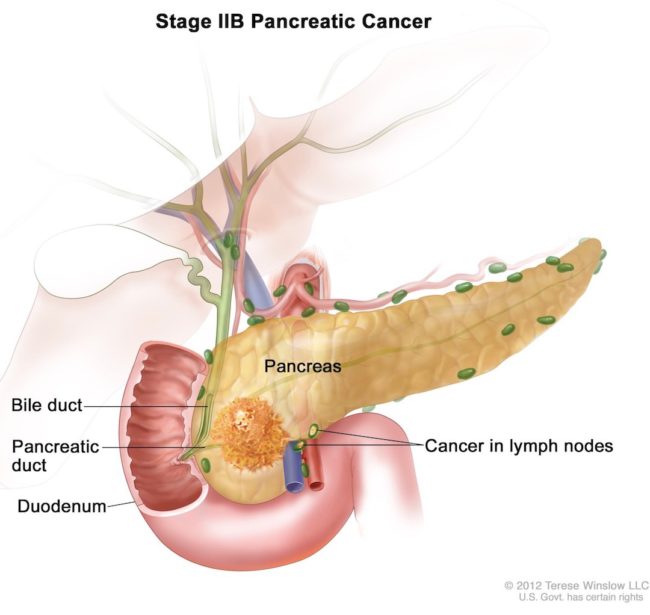
Image L
Let’s close this lesson on a happier note with Culinary Considerations.
Sweetbreads or Sweet breads??? Let’s get this out of the way, right now! Sweetbreads are thymus and pancreas (and, often salivary glands). Yes, people eat pancreas (Image M), gah! I canna like this as I have met too many of these organs on the dissection table. To me, sweetbreads are Awful-Offal! They do enjoy legions of fans, so dive in, if they work for you. You can have my share <G>
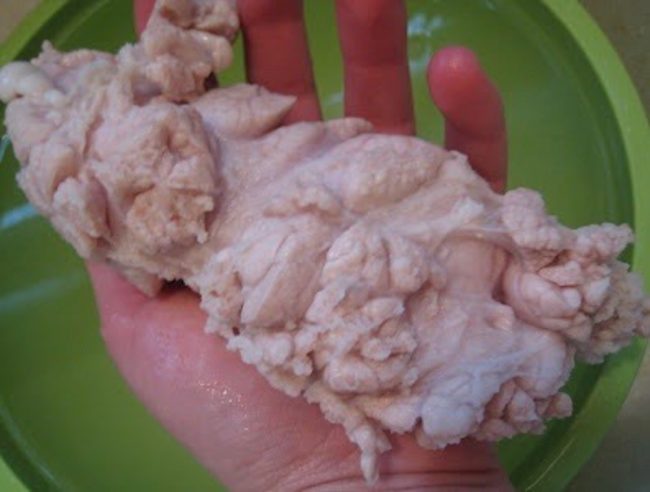
Image M
On the other hand, sweet breads (Image N) are verra hard to resist, especially the homemade variety. Yummy, yummy, yummy, in my tummy, tummy, tummy! ‘Nuf said!

Image N
Let’s give the last word to American poet Robert Frost because he was creative enough to write a poem about sweetbreads.
Quandary
You drive me to confess in ink:
Once I was fool enough to think
That brains and sweetbreads were the same,
Till I was caught and put to shame,
First by a butcher, then a cook,
Then by a scientific book.
But ’twas by making sweetbreads do
I passed with such a high I.Q.
Dear Robert: the butcher, baker and candlestick maker – och! -butcher, cook, and science book are correct! Sweetbreads dinna include brain!
A deeply grateful,
Outlander Anatomist
Photo Creds: Starz, www.123rf.com (Image E pancreas parts), www.blog.kingarthurflour.com (Image N sweet breads)
www.cancer.gov (Image D pancreas site), www.dypatil.edu (Image B Herophilus), www.en.wikipedia.org (Image I Aretaeus), www.fanart.tv (Image A Space Cowboys), www.healthtop.com (Image C pancreas), www.mayoclinic.org (Image K pancreatic transplant; Image L Pancreatic Cancer), www.medicalwork.com (Image G pancreas mixed gland), www.medievalspanishchef.com (Image M sweetbreads), www.pancreatic.org (Image F pancreas ducts), www.shutterstock.com (Image H pancreas histo), www.threadless.com (Image J shirt)
